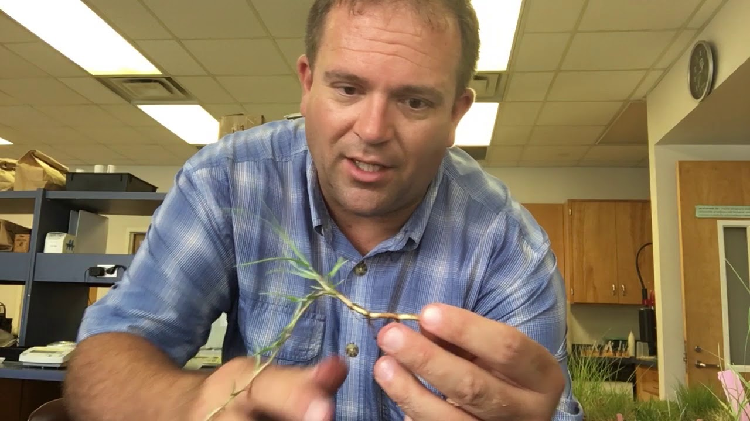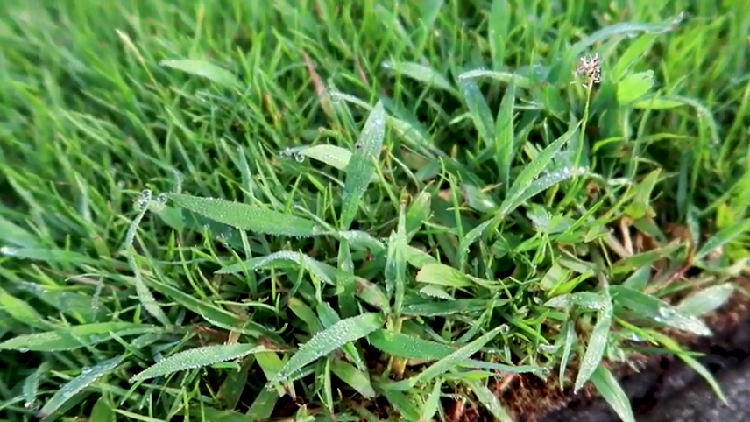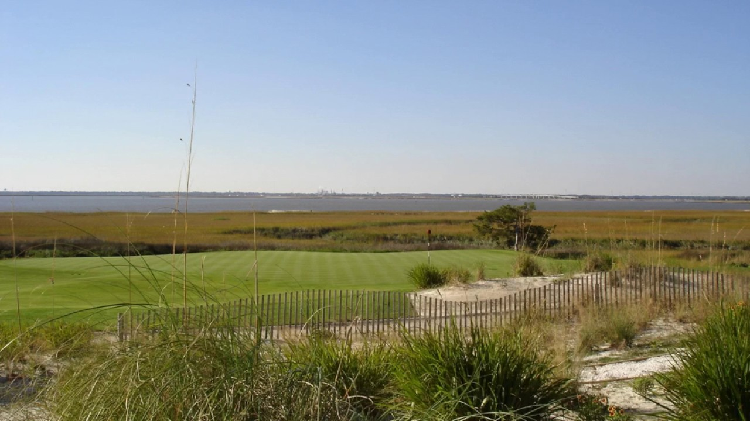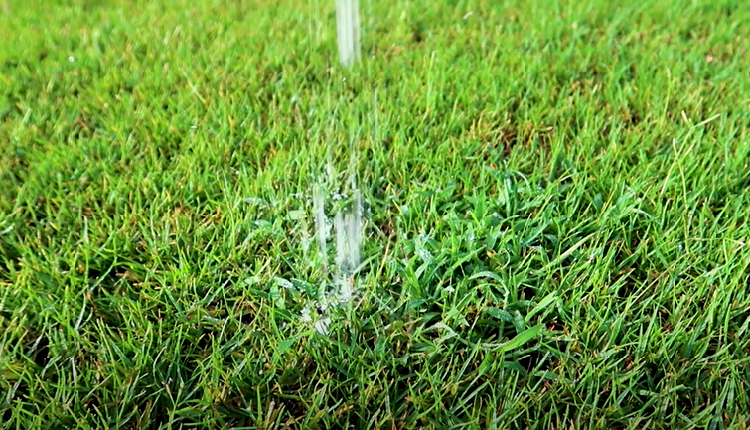- Best Grass Seed for Clay Soil - April 3, 2022
- Seashore Paspalum Guide – Warm-Season Grass - January 30, 2022
- Best Grass Seed for South Carolina - January 20, 2022
In this Seashore Paspalum guide, we’ll see how this plant, that’s also known as Paspalum vaginatum in scientific terms, is a warm-season grass that’s especially exceptionally adapted to salty and moist areas commonly found along the coast.
It withstands infertile and sandy soils, high concentrations of salt, waterlogged conditions, and sporadic inundation by seawater. This turf grass also has numerous morphological traits that make it a desirable option.
Seashore Paspalum produces rhizomes and stolons, has an appealing bright green color, good resistance to low cutting, good density, and a moderate to delicate leaf texture. The grass is arguably the most salt-resistant type and also has high potential for soil stabilization and reclamation of abandoned salt-affected areas.
Our Bottom Line Upfront: Seashore Paspalum’s a perennial warm-season grass that generates rhizomes and rapidly spreads by stolons. It withstands wet soils, high salt concentrations, and extended cloudy conditions.
Most commonly used as a turf grass for sports like golf, soccer, American football, baseball, etc, it adapts best to coastal tropical and subtropical areas around the world.
Seashore Paspalum Propagation

Seashore Paspalum is planted by seeds, stolons, sod, plugs, or sprigs. Stolons should be spread at 5-10 bushels every 1,000 square feet on a properly prepared seedbed.
Next, you should apply 1 pound of nitrogen starter fertilizer per 1,000 square feet, or according to the recommendations of your soil analysis.
After stolonizing, you should apply a ½ -inch of mulch layer above the stolons to help hold them in place and retain moisture. Alternatively, you can also do some shallow tilling. You should follow up both methods by lightly rolling the soil with a roller to ensure adequate contact between the stolons and soil.
Applying an approved pre-emergent herbicide can minimize the germination of weed seeds. A well-watered and fertilized sowing should cover the ground within 2 ½ to 3 months. Plugs and sprigs will take around the same duration if they’re planted at not more than 12-inches apart.
Seashore Paspalum Soil Types
A wide variety of soil types will suit Seashore Paspalum, including poorly drained and heavy soils. The grass has been shown to grow well in acidic and clayey soils, as well as sandy and calciferous soils, with pH values of between 5 and 8, respectively.
Uses of Seashore Paspalum
All kinds of golf courses—think private, public, municipal, championship, and resort—use Seashore Paspalum. Since it tolerates various cutting heights, the turf grass is the most versatile variety for golf courses and is often planted wall-to-wall.
Seashore Paspalum’s strength, density, and swift recovery make it an excellent option for sports fields. Sports like American football, soccer, rugby, baseball, and horse racing use Seashore Paspalum at different levels from leisurely to professional competitions.
In addition, residential and commercial landscaping projects regularly use Seashore Paspalum.
In the field of infrastructure, projects requiring mining as well as soil stabilization, roadway, and airport jobs use Seashore Paspalum.
A less common but very effective purpose of Seashore Paspalum is remediation. The grass can take out toxic chemicals from water or soil, restoring previously abandoned areas to usable and safe conditions.
The Benefits of Seashore Paspalum

Popularly known to highly tolerate salty conditions, Seashore Paspalum has garnered a good reputation for sustainability.
The turf grass outperforms other varieties thanks to its capacity to grow and flourish in sodic soils, with sewage water irrigation, and in regions with high levels of sea spray.
Seashore Paspalum has a unique way of processing salt, unlike other turf grasses. When it comes to salt tolerance, Bermuda grass is the least tolerant. Unable to withstand any considerable amount, the salt remains stuck to the Bermuda grass root. Zoysia grass tolerates salt better than Bermuda grass but it only pushes salt upwards onto the leaf blades.
Seashore Paspalum develops roots faster than Zoysia or Bermuda grass. Rapid establishment after seeding, sodding, or sprigging allows Seashore Paspalum to establish itself in record time. When it comes to seeded Paspalum, this means lower planting rates, resulting in cost savings.
Seashore Paspalum’s unique striping benefits are a distinct plus for golf courses and sports fields. Due to the turf grass’s bright green color, one round of mowing shows distinctive striping patterns while it takes at least two rounds of mowing on Zoysia or Bermuda grass to show the same.
Maintained properly, Seashore Paspalum needs less nitrogen than other warm-season grasses, including Zoysia and Bermuda. The environmental impact of these benefits is a major reason why Seashore Paspalum is popular with projects focusing on sustainability.
Seashore Paspalum’s low light tolerance, which is better than that of Bermuda grass or most Zoysia grass species, allows the grass to flourish in conditions where numerous other turf grasses wilt. Geographic areas with spells of minimal sunlight and heavy cloud coverage are ideal for Seashore Paspalum.
Seashore Paspalum’s ability to withstand low light conditions also makes it the natural grass of choice for stadia where sections of the pitch receive limited sunlight.
Seashore Paspalum’s solid, dense canopy and the resultant durability provide outstanding wear tolerance, enabling it to withstand cart movement on golf courses and excessive foot movement on sports pitches.
With rapid recovery thanks to dense rhizomes growing horizontally, divots in Seashore Paspalum grow back quicker than in slow-growing Zoysia or Bermuda grass.
The rich bright green of Seashore Paspalum provides an added advantage when it comes to cost savings and aesthetics. When temperatures drop, Seashore Paspalum retains its rich green color longer, lessening the need for painting the turf and potentially avoiding having to overseed.
Which Pests Attack Seashore Paspalum?
Seashore Paspalum is vulnerable to the occasional grass armyworm, fiery skipper, and webworm attack. But the good news is that birds and other predators are usually able to keep these pests in check.
If there’s a need for treatment, applying an approved insecticide just once should suffice. Grass armyworm and webworm can be controlled by Bacillus thuringiensis, a form of bacteria sold under different trade names.
Seashore Paspalum can also be afflicted by a fungal disease, but this is normally only an issue when the turf grass is stressed. Proper cultural practice, fertilization, and watering will minimize the impact of any fungal disease.
It’s important to keep your Seashore Paspalum lawn weed-free from the time it establishes itself. You can do this by hand-pulling or applying a pre-emergent herbicide. Once Seashore Paspalum has covered the area completely, there will be minimal weed invasion as long as you properly maintain the lawn.
How to Properly Maintain Seashore Paspalum

Fertilizer Application
- Seashore Paspalum requires 66% less nitrogen (N) fertilizer than Bermuda grass. As such, you should treat it with 2 to 3 pounds of nitrogen per 1,000 square feet each growing season.
- Don’t exceed 4 pounds of nitrogen per 1,000 square feet.
- Seashore Paspalum really thrives with slow-release fertilizers, which are best applied in early fall and spring, but they can also be applied in the summer if necessary.
- Additional products that may provide a rapid green up include foliar application of seaweed extracts, which can be derived from products like Kelplex 1-2-2, Roundup ProMax, and PanaSea Plus. These are sold at most nurseries or online.
- Seashore Paspalum’s water and fertilizer requirements have made the grass very popular as it uses a lot less nitrogen than Bermuda grass.
- When it comes to watering, the schedule is a bit different from that of Bermuda grass because it can withstand heat stress much better after two to three days of watering.
- Slow-release fertilizers can be applied to help lower water bills by restricting growth.
Watering

- Deep and occasional watering of established Seashore Paspalum is the best option. Water every two or three days during the growing period and apply 1 inch of water every week.
- As a general rule, apply water for 10 minutes for every day your lawn wasn’t watered. For places where water can’t penetrate the soil or extreme slopes, it’s best to irrigate in a cycle-soak pattern to let the water penetrate the soil without running off.
- You should water Seashore Paspalum in the early morning to rule out any competition in the environment.
Mowing
- Depending on its purpose, Seashore Paspalum has many different mowing heights. For a backyard, the grass can be kept as tall as two inches. It can also be kept as a putting green.
- Choose your preferred turf height. Continue mowing while keeping this height in mind so that not more than a third of the height is cut off at a time.
- You should mow Seashore Paspalum once or twice a week to maintain your desired height.
Herbicide Application
- You can apply pre-emergent herbicides in February and then apply post-emergent herbicides during the growing period.
- Water and rock salt solution has been shown to treat specific broadleaves.
Overseeding Seashore Paspalum
- You can overseed Seashore Paspalum during the cooler months to preserve winter color. It’s ideal to start the overseed process when nighttime temperatures drop to the low 60s Fahrenheit.
- Before you scalp for the fall, lift the height by half an inch. Keep your lawn at this particular height for 14 days before scalping. Then scalp down the lawn a bit lower than the usual mowing height to 0.5-inches or 0.75-inches.
- At this time, you can do a light verticut to open the turf canopy up and mow to clear any extra debris remaining on the turf.
- Next, apply some starter fertilizer to your mowed turf, for example, 18-24-12, 11-52-0, 16-20-0, or 6-20-20.
- Seed a perennial ryegrass lawn at 10 to 12 pounds per 1,000 square feet. Make sure to use a top-quality seed mixture that’ll provide a rich green shade throughout the winter.
- Apply 5-7-minute cycles of water three to four times throughout the day to ensure the seedbed stays moist during the germination and growing of ryegrass.
- Ten days after sowing, apply another fertilizer to encourage the growth of ryegrass, for example, 15-15-15.
- Apply a third and final fertilizer after mowing the lawn, when it’s thriving shortly before the initial frost. Early November is the ideal time to apply the third fertilizer and some good options to use include 15.5-0.0, 21-7-14, or 15-15-15.
- Applying these fertilizers is vitally important as ryegrass does begin to acquire a yellow tone after a severe frost. This won’t be a problem with proper timing, though.
- During the cooler times of the year, make sure to apply foliar fertilizers if necessary to preserve color.
Spring Transition
- Seashore Paspalum will start to grow once the temperature of the soil hits 64 degrees Fahrenheit for three days in a row. At this time, start to reduce the ryegrass’s height gradually and cease any fertilization.
- Seashore Paspalum will come into view and conquer ryegrass as temperatures get ideal for growing. When Seashore Paspalum starts to emerge, you should opt for a slow-release fertilizer to decrease too much top growth.
- A good starter fertilizer for the growing season includes Soil Burst 4-4-2, 18-24-12, 6-20-20, or 11-52-0.
Verticutting and/or Aeration
- You can aerate or verticut Seashore Paspalum during the growing period. How much you should verticut or aerate will depend on your specific lawn and the amount of traffic it’s receiving.
- The best time to do some light verticutting on Seashore Paspalum is during the growing season (April to September).
FAQs About Seashore Paspalum Guide
Answer: Seashore Paspalum needs a very well prepared seedbed or soil to ensure excellent germination and establishment. Make sure the seedbed is clean and has no other grasses. The depth of the seed shouldn’t be more than 0.25 inches and you should water the seeded area for 45-minute spells 3-4 times daily.
Answer: Seashore Paspalum is a medium to rough-blade bright green grass with a dense system of roots and aggressive way of growing. The ligule is in the form of a short membrane and auricles are absent. Its leaves are twisted in the bud and the grass spreads by rhizomes.
Answer: You should apply moderate amounts of fertilizer and water to your Seashore Paspalum lawn and frequently mow it to keep a low cut. The grass is difficult to mow and recovers fairly slowly from mowing damage. But it’ll highly tolerate salt and heat as well as some shade.
Answer: Seashore Paspalum should always be mowed with sharp lawn mower blades to prevent leaf tissues from being torn.
Once Seashore Paspalum is established, it needs some fertilization. Optimal nitrogen fertilizer application rates per year range from 5 to 8 pounds per 1,000 square feet for athletic fields, golf course fairways, tees, and other landscape places.
Answer: Seashore Paspalum is originally from tropical and subtropical areas of South America and North America. In the US, Seashore Paspalum is grown along coastal areas from Florida to Texas and southward in North Carolina. The grass is also used to make turf grass in Australia, New Zealand, and South Africa.
The Takeaway on Seashore Paspalum Guide
Seashore Paspalum, aka Paspalum vaginatum in scientific language, is a tropical and subtropical type of grass that’s more commonly used in the turf grass arena.
In the US, it’s native to California’s coastal area and the Gulf of Mexico’s coast. What makes this turf grass different from the rest of the warm-season grasses is its ability to tolerate extremely salty soils.
With medium to coarse grass blades, Seashore Paspalum has a dense system of roots and grows very aggressively. This light to medium green turf grass spreads by rhizomes and stolons. It’s available in seed and vegetative form, allowing for several planting options, including seeding, sodding, or sprigging.
Seashore Paspalum needs moderate quantities of fertilizer and water and requires regular mowing to keep a low cut. This type of grass highly tolerates salt and heat as well as low light. It can withstand a high amount of traffic and can quickly recover from moderate wear and tear during the spring and summer.

